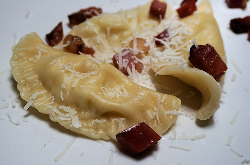피로기 만두

Chinese steamed buns. Italian ravioli. Indian samosas. No matter where you live, chances are there is a local dumpling -- a small mass of dough usually cooked with meat and vegetables inside.
Today, we are talking about the pierogi, a dumpling from Eastern Europe. Traditional pierogi fillings include potatoes, sauerkraut, cheese and even fruit.
Olena Apostoluk is an American of Ukrainian-English descent. She has been making pierogis for 17 years.
“We call it ‘pyrohy’ but really, it’s ‘varenyky’ because you are boiling it. So, Americanized it’s ‘pierogis, pyrogis’ -- depends on where you come from.”
Olena operates a volunteer food project out of the St. Josaphat Ukrainian Catholic Cathedral near Cleveland, Ohio. It is called the Pierogi Project. It raises money to help pay the cost of operating the church.
Olena and her team prepare and sell 130 to 180 kilograms of pierogis to the public every Thursday and Friday. During the Christian holidays of Lent and Christmas, they make and sell about 600 kilograms of pierogis each week.
“The people who buy pierogis are regular people that have been buying pierogis from us for many years. Or a lot of people are word-of-mouth. I do have a handful of restaurants and bars that buy from me.”
Making hundreds and sometimes thousands of pierogis by hand each week is a lot of work. Olena prepares for the task by completing a special job each day. On Monday, the sauerkraut filling is prepared.
The mixture arrives in a large container. Olena rinses it in water and then presses the water out. She adds spices, and then forms the filling into small balls.
On Tuesday, the potato filling is prepared. Olena uses only potatoes that cook well in water: the Russet Norkotah or Burbank from the state of Idaho. She and her team hand peel, cook, and smash about 20 kilograms of potatoes or more. The cheese filling is also prepared on Tuesday.
On Wednesday, Olena prepares the dumpling dough. “The dough recipe was given to me by my mother-in-law. Everybody has their own little dough recipe but mine works for me. It’s nice and soft. The customers that come in, they really like our dough.”
For the dough, Olena mixes about 10 kilograms of flour with water, milk and salt in an electric mixing bowl for about 20 minutes. She knows from touch when the dough is ready to cool.
Early on Thursday, the whole team comes together for the final stage of the pierogi production.
“The dough is rolled out and then after it’s rolled out there’s a roller that will cut the rounds. The ladies over there, they are pinching. We call it pinching pierogis. So, they are just taking the dough rounds and making sure that they are closed, so that when we cook them, they don’t open up.”
After the pierogis are put together, they are boiled, and then packaged. At 8 in the morning, the first pierogis go on sale.
Linda Hupert has been working on the Pierogi Project for about four years. Before that, her mother was a volunteer. But now, she says she doesn’t have much family left.
"So, my family has become the people here at church. So, that’s my extended family."
The Pierogi Project does more than make pierogis for the community. It brings people together.

